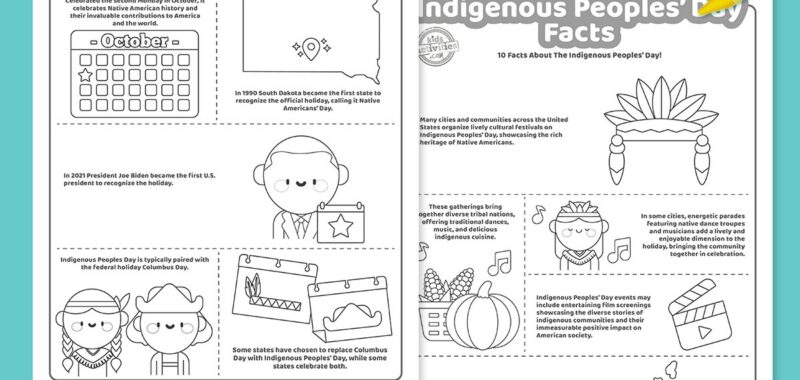Let’s celebrate Indigenous Peoples’ Day! Today we are learning all about this holiday: why it originated, how to celebrate it, and why it’s so important for people to know about it. And because we want to make the learning process a more hands-on and engaging experience for kids, we’ve made a collection of free printable facts about Indigenous Peoples’ Day, along with simple drawings next to each fact for kids to color.

What is Indigenous People’s Day and Why is it Important?
Before we dive into the facts and creative activities, let’s explore the significance of this holiday and how you can incorporate these resources into your classroom or home learning environment.
Download here: Indigenous Peoples’ Day Facts
When is Indigenous People’s Day?
Indigenous Peoples’ Day is a national holiday celebrated on the second Monday of October, designed to honor and recognize the contributions of Native American communities in the United States.
This day stands as a counter-celebration to Columbus Day, which traditionally commemorated Christopher Columbus’ arrival in the Americas, overlooking the impact this had on native peoples. Indigenous Peoples’ Day serves as a more inclusive way to commemorate this date and provides an opportunity to celebrate the rich and diverse history, culture, and resilience of Indigenous communities.
How to Use Our Facts about Indigenous Peoples’ Day
Using Indigenous Peoples’ Day in your classroom is a wonderful way to educate young minds about the history and culture of Native American communities. These free printable facts and coloring pages offer a creative and engaging tool for teaching about this holiday.
You can use them to start meaningful discussions about the importance of cultural diversity, the significance of respecting indigenous traditions, and the exploration of Native American history. These resources provide an opportunity for students to learn while having fun and coloring beautiful drawings. Whether you’re a teacher or a homeschooling parent, these materials are a fantastic addition to your educational resources.
Facts About Indigenous Peoples’ Day

- Celebrated the second Monday in October, it celebrates Native American history and their invaluable contributions to America and the world.
- In 1990 South Dakota became the first state to recognize the official holiday, calling it Native Americans’ Day.
- In 2021 President Joe Biden became the first U.S. president to recognize the holiday.
- Indigenous Peoples’ Day is typically paired with the federal holiday Columbus Day.
- Some states have chosen to replace Columbus Day with Indigenous Peoples’ Day, while some states celebrate both.

- Many cities and communities across the United States organize lively cultural festivals on Indigenous Peoples’ Day, showcasing the rich heritage of Native Americans.
- These gatherings bring together diverse tribal nations, offering traditional dances, music, dance, and delicious indigenous cuisine.
- In some cities, energetic parades featuring native dance troupes and musicians add a lively and enjoyable dimension to the holiday, bringing the community together in celebration.
- Indigenous Peoples’ Day events may include entertaining film screenings showcasing the diverse stories of Indigenous communities and their immeasurable positive impact on American society.
- Canada has their own version of the holiday, called National Indigenous Peoples Day, and has been commemorated since June 21, 1996.
This article contains affiliate links.
SUPPLIES NEEDED FOR Indigenous Peoples’ Day FACTS SHEETS
- Something to color with favorite crayons, colored pencils, markers, paint, watercolors…
- The printable Indigenous Peoples’ Day facts coloring sheets template pdf — see button below to download & print.
- Facts about Indigenous Peoples’ Day coloring pages are sized for standard letter printer paper dimensions – 8.5 x 11 inches.
DOWNLOAD INDIGENOUS PEOPLES’ DAY Printable FACTS PDF FILE
Download here: Indigenous Peoples’ Day Facts
MORE TO LEARN With KIDS ACTIVITIES BLOG
Did you like these Indigenous Peoples’ Day facts? Check out our other fact sheets!

